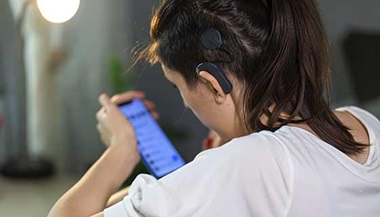Patient Story
Microtia with Atresia: Theo's Story
Patient Story Highlights
- Theo was born with conductive hearing loss. His right ear is much smaller than his left, and there is no opening.
- Theo was using a device with a headband but was approved for a new device that is more discreet.

It’s not that headbands aren’t cool.
Plenty of cool characters have worn them. Jon Bon Jovi. Madonna. Alice in Wonderland. Princess Jasmine. The Teenage Mutant Ninja Turtles. (OK, technically, those might be eye masks.)
But the prospect of a 6-year-old boy heading off to school each day with a medical-grade headband harnessing his hearing aid to his head … well, it’s enough to make a mother worry a little.
Theo was born with conductive hearing loss. Diagnosis: microtia with atresia. His right ear is much smaller than his left, and there is no opening—no ear canal through which sound can travel.
Since age 2, Theo has been wearing the special headband designed not only to secure the hearing device to the correct spot but also to apply necessary pressure to his mastoid bone, just behind his right ear.
Up until first grade, he’d shared a classroom with other hard-of-hearing kids. But this year, Theo was being mainstreamed.
“Honestly, I was crying on his first day of school,” says his mom, Dana, who worried about him fitting in. “It was not just a traditional hearing aid. It was a headband on a little boy.”
The outgoing Theo worked his magic on his first-grade classmates, and they were kind to him. Yet they did ask lots of questions. Theo felt newly vulnerable as the only hearing-impaired student in his school. But the only other available option for him was surgery. His parents weren’t ready for that.
Theo’s dad is in the Coast Guard, and the family will make lots of moves over the course of Theo’s school years. Would he have to go through the challenge of explaining his headgear and his hearing impairment over and over with each new peer group?
Here’s where a parent’s resourcefulness, coupled with a hospital’s willingness to go the extra mile, was about to make a difference for this little boy.
In an online support group, Dana learned about a new bone conduction hearing system called ADHEAR, which was being tested in Europe. Instead of a headband, this system uses a very small adhesive adapter that sticks to the skin over the mastoid bone, directly behind the ear. The audio processor snaps into the adapter. The processor picks up sound waves and converts them into vibrations. The bone conducts the vibrations into the inner ear, where they’re perceived as sound. No need for pressure to be applied to the mastoid bone, as it does with the older device. (Hence the headband.)
Just stick. Click. Hear.
Theo’s parents were excited about this new, more discreet and more practical option. They collaborated with the audiology team at Johns Hopkins All Children’s Hospital, who’d also been seeing news of this product in the literature. Could it be a good fit for Theo?
Lindsay Bolt, Au.D., wanted to help his family find out.
“It’s not about nerve damage for Theo,” Bolt says. “The hearing nerve fires great in response to sound. But because there’s no opening to transmit that sound, he needs extra power to get past it.”
The team hoped the precise placement of the ADHEAR device might give him the extra boost he needed to hear well. As soon as ADHEAR was approved by the Food and Drug Administration in the United States last spring, the Johns Hopkins All Children’s team got to work. They researched the product, set up contracts and helped the family navigate through insurance issues.
In January of 2019, Theo’s headband came off. With this product so new to the United States, he could count himself among the first to get fitted for the device.
Getting It Right
Just shy of a month after he was fitted with his new hearing system, Theo returns to Johns Hopkins All Children’s to check out his progress.
His mom already has noticed big changes. No more ripping off his headband and hearing device when he comes home from school. He forgets he has it on. She is seeing more confidence from her son. He’s pleased that his friends see him now—and not his headgear.
Theo is tucked inside a small sound booth outfitted with colorful games. The audiologist on the other side of the glass begins to feed noise into his “good” ear so he is relying solely on his new hearing device to pick up sounds.
Theo knows the drill. A low voice, barely audible, comes through the speakers.
“Cupcake …”
Theo answers. ”CUPCAKE!”
“Hot dog …”
“HOT DOG!”
Theo is asked to place a colorful toy wedge into a game slot each time he hears a noise. …
He hears a low swishing sound, and pops the wedge into the slot.
There are more tests, and a few audio tweaks. But, overall, this new alternative gets a thumbs up.
“This is great for Theo,” Bolt says. “He hears within the normal range from both ears when he is wearing the device. It will definitely help him academically, socially, and with speech and language.”
“The fact that this is now just a little sticky thing behind the ear, instead of a huge headband. Nobody even talks about it,” says his dad, Leo.
“He’s the one who shows everybody now,” Dana adds. And Theo?
“I think it’s awesome!” he says.
Of course, the better this child hears, the greater his chances of effectively navigating the great big world out there.
Theo is setting himself up for success. And that—is very good to hear.



